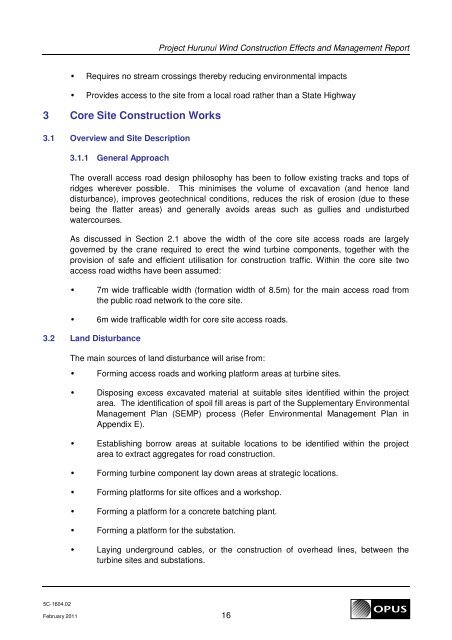Project Hurunui Wind Construction and Project Overview
Project Hurunui Wind Construction and Project Overview
Project Hurunui Wind Construction and Project Overview
You also want an ePaper? Increase the reach of your titles
YUMPU automatically turns print PDFs into web optimized ePapers that Google loves.
<strong>Project</strong> <strong>Hurunui</strong> <strong>Wind</strong> <strong>Construction</strong> Effects <strong>and</strong> Management Report<br />
• Requires no stream crossings thereby reducing environmental impacts<br />
• Provides access to the site from a local road rather than a State Highway<br />
3 Core Site <strong>Construction</strong> Works<br />
3.1 <strong>Overview</strong> <strong>and</strong> Site Description<br />
3.1.1 General Approach<br />
The overall access road design philosophy has been to follow existing tracks <strong>and</strong> tops of<br />
ridges wherever possible. This minimises the volume of excavation (<strong>and</strong> hence l<strong>and</strong><br />
disturbance), improves geotechnical conditions, reduces the risk of erosion (due to these<br />
being the flatter areas) <strong>and</strong> generally avoids areas such as gullies <strong>and</strong> undisturbed<br />
watercourses.<br />
As discussed in Section 2.1 above the width of the core site access roads are largely<br />
governed by the crane required to erect the wind turbine components, together with the<br />
provision of safe <strong>and</strong> efficient utilisation for construction traffic. Within the core site two<br />
access road widths have been assumed:<br />
• 7m wide trafficable width (formation width of 8.5m) for the main access road from<br />
the public road network to the core site.<br />
• 6m wide trafficable width for core site access roads.<br />
3.2 L<strong>and</strong> Disturbance<br />
The main sources of l<strong>and</strong> disturbance will arise from:<br />
• Forming access roads <strong>and</strong> working platform areas at turbine sites.<br />
• Disposing excess excavated material at suitable sites identified within the project<br />
area. The identification of spoil fill areas is part of the Supplementary Environmental<br />
Management Plan (SEMP) process (Refer Environmental Management Plan in<br />
Appendix E).<br />
• Establishing borrow areas at suitable locations to be identified within the project<br />
area to extract aggregates for road construction.<br />
• Forming turbine component lay down areas at strategic locations.<br />
• Forming platforms for site offices <strong>and</strong> a workshop.<br />
• Forming a platform for a concrete batching plant.<br />
• Forming a platform for the substation.<br />
• Laying underground cables, or the construction of overhead lines, between the<br />
turbine sites <strong>and</strong> substations.<br />
5C-1604.02<br />
February 2011 16
















